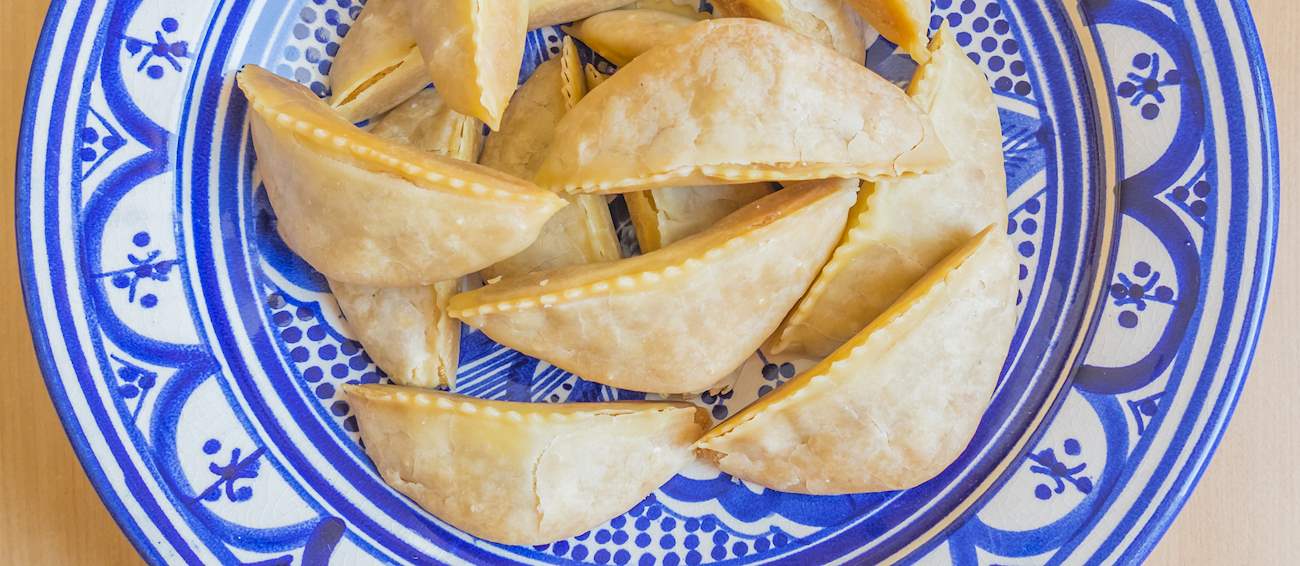Sfenj are popular Moroccan and Algerian doughnut-like fritters made from sticky unleavened batter, similar to Libyan sfinz and Tunisian bambalouni. The dough is traditionally shaped into rings and deep-fried until it develops a golden, crispy exterior.
The interior should be fluffy, tender, and chewy. These fritters are usually served hot when sold by street vendors, and they can be consumed plain or dusted with icing sugar.
MAIN INGREDIENTS
These crescent-shaped cookies are usually associated with Morocco, but they can be found throughout Algeria and Tunisia in slightly different forms and under various names. Their name translates as gazelle ankles, but they are better known as gazelle horns.
They consist of a thin pastry shell that is wrapped around a sweet cinnamon-flavored almond filling. Both filling and the pastry dough are typically enriched with orange blossom water. The cookies can be coated in crushed nuts or optionally dipped in orange blossom water and then dusted with sugar, in which case they are typically referred as kaab el ghazal m'fenned.
Chebakia is a chewy, crunchy, and fragrant Moroccan pastry made by arranging strips of dough into a flower shape. It is then fried, coated in honey, and sprinkled with sesame seeds. This sweet treat is traditionally prepared during the month of Ramadan, and is typically served alongside harira.
It takes a lot of time and effort to prepare chebakia, so Moroccan women often ask sisters, mothers, or friends to help them in making large quantities of these cookies.
Ktefa or jawhara is a layered Moroccan dessert that is assembled with paper-thin sheets of fried warqa pastry. The filling between the crispy layers is usually made with a combination of toasted ground or roughly chopped almonds and sugar, while the whole dessert is served doused in a custard cream that is flavored with orange blossom water.
Ktefa or jawhara consists of five to six layers and may come garnished with almond slivers, cinnamon, powdered sugar, mint, or fresh fruit. The dish is also popular in France, where it goes as pastilla au lait.
M’hanncha or snake cake is a traditional dessert in which warqa pastry is filled with a delicious almond paste, then shaped into a snake-like form. Although there are numerous recipes for the almond paste, it is typically prepared with almonds, sugar, cinnamon, mastic powder, butter, and orange flower water.
M’hanncha can be shaped into small coils, but at social gatherings and festive occasions, it is made in a large version, so the guests can enjoy it by breaking off smaller portions from the end of the coil. When baked, the pastry is often dusted with powdered sugar or brushed with warm honey.
TasteAtlas food rankings are based on the ratings of the TasteAtlas audience, with a series of mechanisms that recognize real users and that ignore bot, nationalist or local patriotic ratings, and give additional value to the ratings of users that the system recognizes as knowledgeable. TasteAtlas Rankings should not be seen as the final global conclusion about food. Their purpose is to promote excellent local foods, instill pride in traditional dishes, and arouse curiosity about dishes you haven’t tried.



